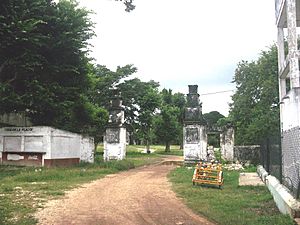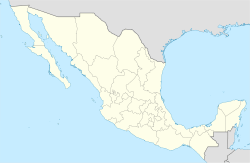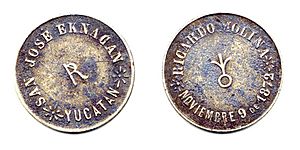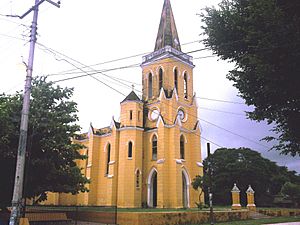Hacienda Eknakán facts for kids
Quick facts for kids
Hacienda Eknakán
|
|
|---|---|
|
Private Residence
|
|

Entrance Hacienda Eknakán, Yucatán.
|
|
| Country | Mexico |
| Mexican States | Yucatán |
| Municipalities | Cuzamá Municipality |
| Time zone | UTC−6 (CST) |
| • Summer (DST) | UTC−5 (CDT) |
| Postal code |
97577
|
| Area code | 988 |
Hacienda Eknakán, also known as San José Eknacán, is a special old estate in southeastern Mexico. It's located in the Cuzamá Municipality in the state of Yucatán. You can find it about 48 kilometers (about 30 miles) southeast of the city of Mérida, between the towns of Acanceh and Cuzamá.
Hacienda Eknakán was built in the 1800s during a time when a plant called henequen was very important. What makes this hacienda unique is that it was planned to be a religious center, built around its beautiful church.
Contents
What's in a Name? (Toponymy)
The name "Eknakán" comes from the Mayan language. It means "the black house of the snake."
Getting There
If you wanted to visit Hacienda Eknakán, you would take highway 180 east from Mérida. Then, you'd turn south onto highway 18 towards Acanceh. From Acanceh, you'd follow the road southeast to Eknakán. The hacienda is about 4 kilometers (2.5 miles) before you reach the town of Cuzamá.
History of the Hacienda
Hacienda Eknakán first started as a place where cattle were raised. Later, it changed to growing henequen. This plant was used to make strong fibers for ropes and other products.
In 1872, a man named Richard Molina Solís bought "San José Eknacán." Just three years later, he started planting henequen for business. He quickly made the planting area much bigger. To grow his business even more, Molina bought another hacienda called Dzitiná in 1901. In 1903, he also bought Hacienda San Isidro Ochil, which was about 20 miles south.
Changes to land ownership, called agrarian reforms, began in Eknakán in 1919. This meant that some of the hacienda's land was given to nearby towns. By 1921–1922, nearly 1,500 hectares (about 3,700 acres) of land were given to the town of Seyé. In 1923, the hacienda lost another 861.94 hectares (about 2,130 acres) to Cuzamá. Even though the owners tried to fight these changes in court, the land decisions were upheld in 1929. More land was also given to Acanceh.
Despite these land disputes, the henequen production at Eknakán stayed in private hands until 1935. When more land reforms happened in 1937, the hacienda owners' land was reduced to 144 hectares (about 355 acres).
In the late 1950s and 1960s, the hacienda started raising animals again, like chickens, cattle, and pigs. This was a way to move away from relying only on henequen. Another interesting fact is that the owners did scientific tests to find better ways to plant henequen and get more of it.
Today, Hacienda Eknakán is owned by Ernesto Molina García.
Amazing Architecture
The Church
The church at Eknakán is built in a style called German Gothic architecture. This style is known for its tall, pointed arches and beautiful details. Today, the church is like a museum.
Inside, you'll see many colorful stained-glass windows. Some are in classic Gothic shapes, and others are round. These windows fill the church with beautiful colored light.
The choir loft, where singers stand, is held up by white stone columns. The main altar also has columns and wooden decorations. You reach it by climbing granite stairs. To one side, there's a small chapel with a carved table holding a statue of San Francisco and a wooden horse.
There's also a large oil painting of the Virgin Mary in a huge, carved wooden frame. Old bells, bowls, a special basin for baptisms, a closet with priestly clothes, and three wooden chests are also on display. The church is so tall that you can see it from far away and from other haciendas nearby.
The Hacienda Buildings
Hacienda Eknakán is made up of two main parts. The first part is surrounded by a wall and includes the main house and other old buildings. The second part is built around a large open square. Here, you'll find the chapel and the powerhouse, along with the village where the farm workers used to live.
The oldest buildings are inside the walled area. These were used when the hacienda was a cattle ranch. The main house sits on a raised platform. Its front and back have arched porches. You can see a mix of different architectural styles, like eclectic and neoclassical, especially at the main entrance stairway.
The second area holds the buildings used for henequen production. This includes the shredder, where the plant fibers were separated, the machine room, the storage cellar, and the area where the fibers were packaged.
Cenote Papak'al
A cenote is a natural pit, or sinkhole, that forms when a cave ceiling collapses, revealing an underground pool of water. Cenote Papak'al is located on the hacienda grounds, near some of the old ruins.
From the entrance, there's an underground chamber that's about 50 meters (164 feet) long and 40 meters (131 feet) wide. The ceiling is about 20 meters (65 feet) high. This chamber leads down to a pool of clear water. Inside, you can see many stalactites (rock formations hanging from the ceiling) and stalagmites (rock formations growing from the floor). The underwater part of the cave has about 380 meters (1,246 feet) of explored passages. These passages were first explored in 1982.
People of Eknakán (Demographics)
Before 1937, many people lived and worked directly on the henequen plantations. However, in 1937, President Lázaro Cárdenas made a big change called agrarian land reform. This change turned the haciendas into collective farms called ejidos. This meant that most of the land was given to the community for shared use, and the former landowners could only keep about 150 hectares (370 acres) for their private property.
Because of these changes, the population figures before 1937 show people living on the farm itself. After 1937, the numbers show people living in the community, as Hacienda Eknakán only housed the owner's family.
According to a census in 2010, the community had 698 residents. Of these, 364 were men and 334 were women. Since then, the people living in this area are counted as part of the larger city of Mérida.
Photo gallery
See also
 In Spanish: Eknakán para niños
In Spanish: Eknakán para niños












